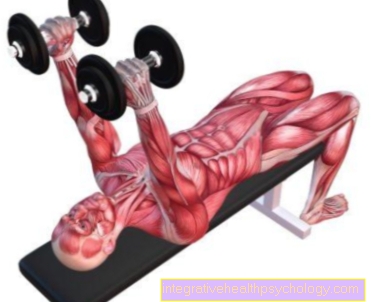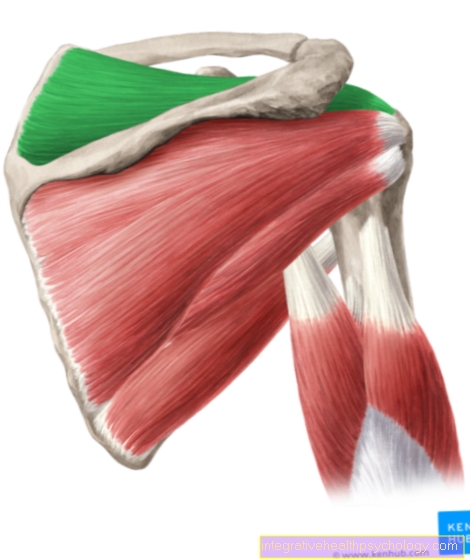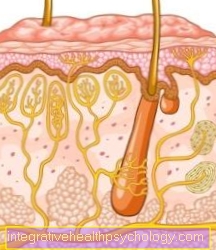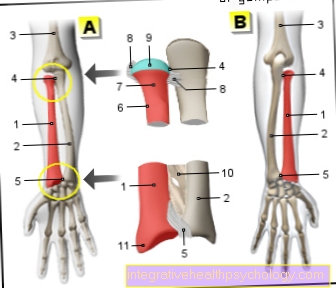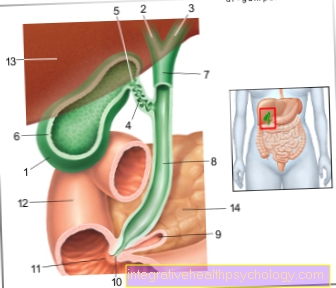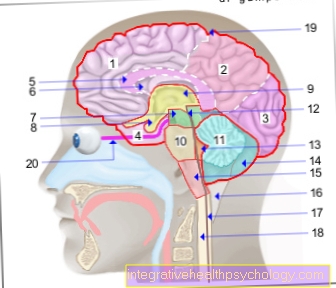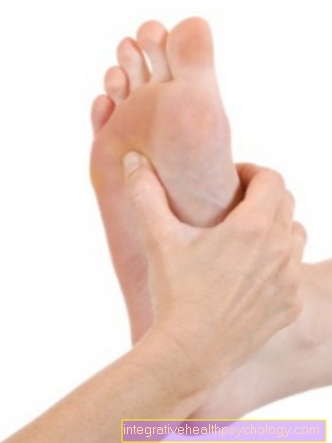Breastfeeding
introduction
Breastfeeding offers the newborn an optimal supply of all the nutrients it needs and also offers many advantages for the mother. On this page you will find a lot of helpful information about breastfeeding.
You can find an initial overview of the topic at: Breastfeeding - All You Need To Know

Benefits of Breastfeeding
Breastfeeding has numerous health, economic and, above all, emotional benefits for both mother and child.
Advantages for the child
- The first bilirubin-containing bowel movement can be stopped quickly thanks to the digestive stimulant milk (lower risk of jaundice)
- optimal nutrient uptake through simultaneous delivery of digestive enzymes in breast milk
- optimal nutritional composition of breast milk (so.)
- Adaptation to increasing energy requirements during breastfeeding by increasing the fat content of breast milk during breastfeeding
- high proportion of long-chain, polyunsaturated fatty acids (promote growth of the CNS, brain and thus the development of intelligence and learning ability)
- Milk sugar in breast milk builds up a strong immune system in the colon bacterial flora
- "Nest protection": Antibodies contained in breast milk, which the child cannot produce in the first few months, strengthen its immune system
- proven rarer occurrence of many diseases such as gastrointestinal infections, upper airway infections, otitis media and bladder infections, sudden infant deaths and allergies in infancy as well
- close mother-child relationship through breastfeeding
Read more on the subject at:
- Breast milk
- Nest protection - what is it?
Benefits for the mother
- intimate relationship with the child
- More serenity through the release of the breastfeeding hormones prolactin and oxytocin, which strengthen the mother's care and attachment capacity
- Reinforcement of self-confidence and intuition
- Ease of everyday life and independence: the milk is always available, is hygienically harmless and at the right temperature
- Cost savings
- Weight reduction due to the increased calorie loss when breastfeeding
- faster uterine regression due to the release of the hormone oxytocin
- lower risk of developing osteoporosis, breast cancer or ovarian cancer
The breastfeeding process
The fact that breastfeeding actually gets going is justified by a reflex cycle. The child has already learned the search-suck-swallow reflex sequence in the womb. In some children, this reflex to breastfeed is not yet so pronounced, so breastfeeding is a little difficult at first and can be painful. After a while, however, the children have mostly learned what to do to get milk.
If the child now sucks on the breast to breastfeed, sensitive nerves in the areola are stimulated. This stimulus is passed on to the mother's brain, where it causes a massive release of the hormones prolactin and oxytocin. While prolactin causes milk to be produced, oxytocin ensures the flow of milk, i.e. the transport of milk towards the nipple. The woman can perceive this so-called milk ejection reflex as a tingling or tingling sensation. Since it is triggered on both sides, the milk can run out of the other breast while breastfeeding. Furthermore, the touch of the mother's nipple by the child causes the so-called nipple erection reflex: The nipple becomes firmer and longer, making it easier for the child to find and then suckle the nipple while breastfeeding.
In order to get rid of any air swallowed while drinking, many children belch after breastfeeding. Since this also prevents flatulence and spitting, you should support your child. To do this, put it over your shoulder after drinking and gently patting your back from bottom to top. A burp cloth on the shoulder prevents "small mishaps". The peasant is not a must, however. If your child has not swallowed air, it will not belch after breastfeeding.
Proper breastfeeding
When breastfeeding, you should always choose a position that is comfortable for both mother and child. This can be standing, lying, sitting or walking. A pillow is often an advantage to relieve the arm or back. If possible, the child should be positioned so that his body is facing the mother's while breastfeeding and his mouth is in front of the nipple. The child should always be brought to the chest and not the other way around. It is important to change breastfeeding positions frequently. This ensures a good, if never complete, emptying of the breast and the nipples are spared. In the lying position, the mother should be on her side and support her own and the child's back with pillows so that both are stomach to stomach.
The cradle handle is particularly suitable for breastfeeding while sitting: the mother has a pillow in her back as well as on her lap, with which she either supports her arm while holding the child's head in the crook of her arm or on her forearm, or the child lies on it the pillow. The arm should then be supported on a backrest. The back grip is particularly suitable for large breasts: The child is placed under the arm "clamped“So that the legs point backwards. In contrast to the cradle grip, in which the child lies stomach to stomach with the mother, it now has its stomach to the side of the mother. His head is supported by his mother's hand.
The breast should be offered to the child with the so-called C-grip. The woman grips her breast from above with her thumb and from below with the rest of the fingers, gently stroking the child's lips. The fingers should be kept at a sufficient distance from the areola so that the child's mouth can also grasp this area.
Read more on this topic at: Behavior during breastfeeding
Breastfeeding multiples
In the case of multiple births, the children can be breastfed one after the other or simultaneously. When breastfeeding at the same time, a poorly drinking child benefits a lot, because sucking on the neighboring breast also triggers the milk ejection reflex on its side.
Due to their different sucking behavior, the children should change their breasts every now and then so that the emptying and stimulation of milk production are the same. Possible stops are:
- Parallel posture: one child lies in the cradle grip, the other in the back grip; the heads point in the same direction.
- Back grip: Both children are “clamped” under the back grip; their heads point towards each other
- X-position: Both children are in the cradle so that their bodies cross like an X.
- V-position: Both children are in the cradle, their bodies form a V.
Duration of breastfeeding
The World health organization (WHO) recommends breastfeeding exclusively for six months. If the baby is already weaned beforehand, the child should be fed with infant milk. Before the fifth month, additional solid food should be avoided in any case. When to wean should be adapted to the needs of mother and child and can definitely only take place after the age of two. From the sixth month, however, depending on the child's hunger, suitable complementary foods should be fed in addition to breastfeeding.

Problems with breastfeeding
Breastfeeding does not always work right away, especially at the beginning, and breastfeeding problems can also arise after a while. Further information can be found on our pages:
- Problems during breastfeeding in the mother
- Painful breastfeeding
- Milk congestion
- Flatulence while breastfeeding
- Problems in breastfeeding in the child
Read about this: Aids in breastfeeding
"Silent strike"
The term "breastfeeding strike" means that the child suddenly and suddenly no longer wants to drink from the breast. This behavior can be triggered by strange smells as well as by the consumption of unknown food, alcohol or medication by the mother. Even after an infection of the child, or a shock from a cry of pain from the mother while breastfeeding, the breast can be rejected as a result.
To bridge the gap, pumping should be carried out or emptying manually so that there is no weaning. This milk should then not come with the bottle, but e.g. fed with a cup. If this condition does not go away after a while, medical advice should be sought.
Obstacles to breastfeeding
Breastfeeding should be avoided if the mother has severe general illnesses such as diabetes mellitus or cancer. Infectious diseases such as HIV infection, active tuberculosis or cytomegaly and measles infections should also not be breast-fed. Substance abuse such as heavy smoking and drug or alcohol addiction are also an obstacle. Metabolic disorders in children can also make breastfeeding impossible. Not to forget to take medication that is incompatible with breastfeeding.
Further information can be found on our pages:
- Medication during breastfeeding
- Ibuprofen while breastfeeding
- Antibiotics while breastfeeding
- Alcohol while breastfeeding
Weaning
To wean immediately after giving birth, the woman is usually given two doses of the drug Dostinex®. In addition, cooling compresses, tight bras as well as sage and mint tea are used. If, after a period of breastfeeding, there is a desire to stop breastfeeding, the child should continue to be fed age-appropriate food. In order to prevent further milk production from being stimulated, the milk should only be emptied manually. Medicines and teas can also stop milk production.
Read more on this topic at: Weaning - what's the best way to do it?
Renewed breastfeeding after weaning
If the mother wants to breastfeed again at some point, some patience is required. The child should have regular close skin contact with the mother and should hold the breasts about every three hours (even if still unsuccessful) to start the milk production again.
This can be optimally solved with a breast feeding kit. The mother wears a bottle with baby food around her neck, from which a tube leads to the nipple. As a result, the infant receives additional food and, increasingly, breast milk at the same time and stimulates further milk production at the same time, so that soon it can only be breastfed.
If this does not work, an electric breast pump can be used to stimulate milk production every two hours a day and once a night.
Breastfeeding-friendly clinics
For breastfeeding, it is particularly important that there is intensive contact between mother and child in the first few hours and days.
With so-called bonding during breastfeeding, it is possible for the two to be in close proximity without interruption in the first hours after birth.
Rooming-in again means that the child is in the mother's room. With bedding-in, the child even sleeps in the maternal bed.
Because of these different options, you should find out about suitable hospitals beforehand and decide based on your individual needs. If you are unsure, you can use the “Breastfeeding-Friendly Hospital” award that clinics receive from WHO and UNICEF if they follow the “10 Steps to Successful Breastfeeding”.



